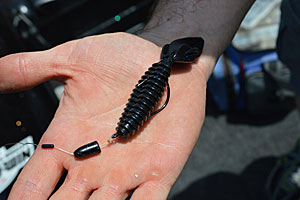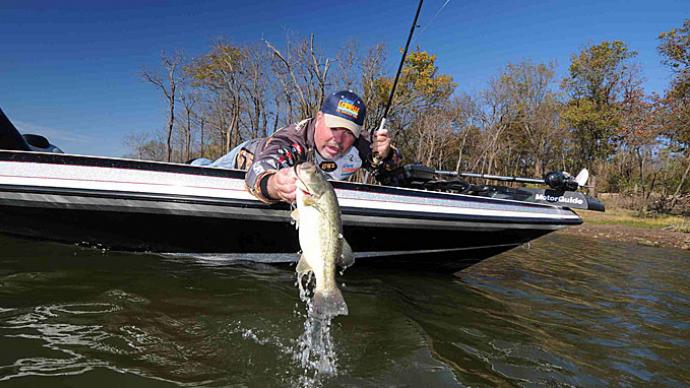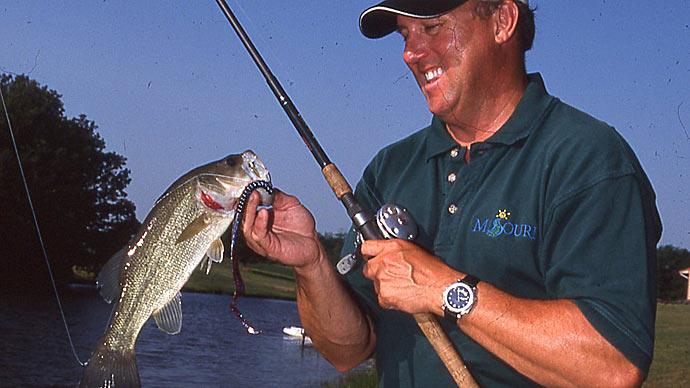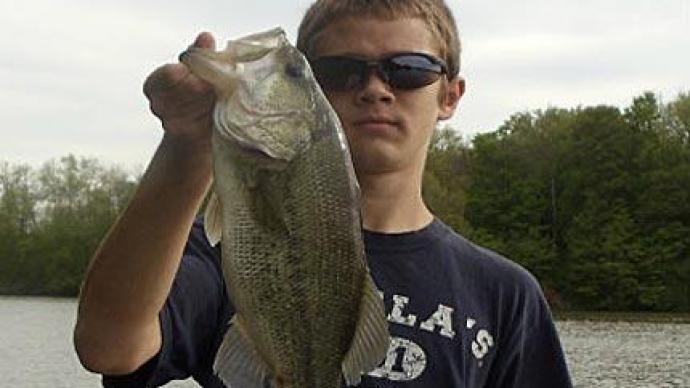| Texas Rig |
|
No bass fishing arsenal is complete without knowledge of Texas rigs. From worms to lizards and grubs, all kinds of plastics can be fished in highly dense vegetation and brush on this rig. Line sizes vary from 14- to 20-pound or more depending on whether you're fishing open water or the thick stuff. When used to flip worms into vegetation or brush, Texas rig fishing shines because they can be made almost weedless by properly inserting the hook point into the bait. The bait must be aligned straight on the hook so that presentation appears more natural. A bunched-up worm doesn't enter the water as well as one that hangs straight. The hardest part about fishing both a Texas and Carolina rig is learning when to set the hook. Many anglers fail to do so soon enough or can't "feel" when needed. You will only feel a slight tick sometimes as the fish picks up the bait and moves off with it. This is often confused with the bumps and snags of underwater limbs or strands of vegetation that can cling and cause almost the same feel. Stage two, setting the hook, can ultimately be as tricky as feeling the tap. Wait too long; the fish drops the bait, set the hook too soon, and miss the strike. Time spent fishing the rig is the best way to gain experience and feel. |

Before I get started with this article, I would like to give you a little background on the development of the worm. In 1949 Nick Creme produced a prototype that would change the fishing industry. This bait had a set of hooks attached to a leader and was embedded in the worm and at the end was a couple of beads and a small propeller. This bait was in almost every tackle box across the country shortly after being produced.
Twenty years later, bass fishing became a prevalent sport, and soon tournaments began to hit the area lakes. The worm was one of the most widely used baits. Creme's Manufacturing company was in Tyler, Texas. This set the stage for the ever-popular name Texas Rig. Nick Creme started adding a slip sinker with his worms and instructions on fish this weedless bait. The 1964 catalog was the first to mention the Texas Rig by Creme.
As fishing became more popular, the worm followed suit. Fishermen now have weights, hooks, and a variety of worms in many colors in their tackle box. The rig consists of a slip sinker or bullet weight, sometimes a tiny glass bead, and a hook. The worm, weight, and hook size preferences vary from fisherman to fisherman.
This is one of the most versatile rigs for fishing. The bait is cast out and allowed to settle to the bottom. Then a slow sweeping motion is used to retrieve it.
You can fish almost anything on a Texas rig for soft plastics. Line size plays an important role, as with any fishing, but the biggest problem with a Texas rig is hanging up. The worm or weight will hang as you drag the bait through stumps and logs. When the bait is pushed down, the hook becomes exposed, and then hung up you are.
Most anglers wanted to use a limber rod back when this rig first appeared, so they could feel the fight when they caught a fish. This was probably the cause of more hang-ups than anything. The rod you use is the most critical part of fishing this rig correctly. You need a medium-heavy rod about six-foot-six inches long with a moderately stiff tip. Some people hate worm fishing because they hang up too much. You need to realize that your bait will be where the fish are, and hang-ups are just part of it.
When setting up the rig, I like to use the smallest weight possible as this makes the bait appear more life-like, and it won't settle into the bottom sediment as quickly. There are days I like to put a bead between the hook and weight, and I have had days the fish don't want the noise.
In the spring, or when pitching the bait, I like to peg the sinker to the top of the worm so the weight won't move. I will use a heavier sinker during this time because I want control over where the bait lands. I have fished 10-inch worms with 1/8-ounce weights. If I fish deep water, I use a heavier weight to get the bait down faster. A grub, fished Texas rigged over grass, or just cast out and swam back to the boat can be deadly. There is no limit to what you can fish or how to fish it when Texas rig fishing.
In 1986, my brother-in-law and I caught 150 bass over the grass on a Texas-rigged worm in four hours by just casting out and slowly reeling back in. You probably could have caught these fish on a lipless crankbait, but look at the time it would take to get it unhooked before casting it again. One hook to mess with and back in the water makes the Texas rig much easier to use in most situations.
I highly recommend wearing glasses or sunglasses when fishing Texas or Carolina rigs. If you hang up, don't pull back with your rod tip as this will load the rod, and if it comes loose, it will be coming back at you with great speed. I had a friend do this, and the bullet weight came back and embedded into his arm. He had to have it cut out. When you hang up, point the rod tip at the hang-up and pull straight back, and this will either break the line or pull loose.
One of the biggest mistakes I see is people get a bite and set the hook, then miss the fish and leave the worm there, thinking the fish might come back. If you set the hook and miss the fish, the best thing to do is hold your rod up high. Reel fast, bringing the bait to the surface and keeping it out of the structure. If you set the hook well, the worm will slide down the hook's shaft, and if you leave it there, you will get hung up. In the old days, everyone thought that they had a bite if they had brought the worm in and moved down the hook. This is not always true. Just hanging up and pulling on the bait while it's hung will pull the bait down. To water has viscosity, and the force you exert to set the hook will slide the worm down even without your being hung up. If you leave the worm after that the hook set, think of this, if the fish does not bite again, and you reel in and hang the structure now, you have spooked the fish sure enough. Keep this in mind the next time you hit your favorite fishing spot.
Good fishing.




